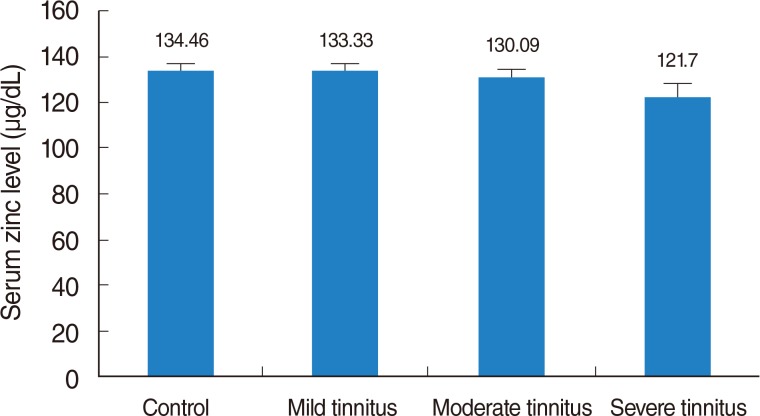Clin Exp Otorhinolaryngol.
2015 Dec;8(4):335-338. 10.3342/ceo.2015.8.4.335.
Is Hypozincemia Related to Tinnitus?: A Population Study Using Data From the Korea National Health and Nutrition Examination Survey
- Affiliations
-
- 1Deparment of Otology, Yeplus Ear, Nose, and Throat Clinics, Ansan, Korea. hjjun1975@gmail.com
- 2Department of Otolaryngology-Head and Neck Surgery, Korea University College of Medicine, Seoul, Korea.
- 3Department of Otolaryngology-Head and Neck Surgery, School of Communication Sciences and Disorders, University of Iowa, Iowa City, IA, USA.
- 4Department of Medical Statistics, Korea University College of Medicine, Seoul, Korea.
- KMID: 2128906
- DOI: http://doi.org/10.3342/ceo.2015.8.4.335
Abstract
OBJECTIVES
The aim of present study was to determine the relationship between serum zinc level and tinnitus using data from the Korea National Health and Nutrition Examination Survey (KNHANES).
METHODS
The present study examined the relationship between serum zinc level and tinnitus using data from the KNHANES. A total of 2,225 KNHANES participants responded to the tinnitus questionnaire and provided blood samples to measure serum zinc concentration. Based on questionnaire responses, participants were categorized into control, mild tinnitus, moderate tinnitus, and severe tinnitus subgroups.
RESULTS
There were no significant differences between groups in serum zinc level after adjustment for sex, age, and hearing loss.
CONCLUSION
It was concluded that hypozincemia is not related to tinnitus in a large population.
Keyword
Figure
Reference
-
1. Moller AR. Tinnitus: presence and future. Prog Brain Res. 2007; 166:3–16. PMID: 17956767.2. Patterson MB, Balough BJ. Review of pharmacological therapy for tinnitus. Int Tinnitus J. 2006; 12(2):149–159. PMID: 17260881.3. Salvi R, Lobarinas E, Sun W. Pharmacological treatments for tinnitus: new and old. Drugs Future. 2009; 34(5):381–400. PMID: 21765586.
Article4. Zirpel L, Parks TN. Zinc inhibition of group I mGluR-mediated calcium homeostasis in auditory neurons. J Assoc Res Otolaryngol. 2001; 6. 2(2):180–187. PMID: 11550527.
Article5. Rarey KE, Yao X. Localization of Cu/Zn-SOD and Mn-SOD in the rat cochlea. Acta Otolaryngol. 1996; 11. 116(6):833–835. PMID: 8973716.
Article6. Speich M, Pineau A, Ballereau F. Minerals, trace elements and related biological variables in athletes and during physical activity. Clin Chim Acta. 2001; 10. 312(1-2):1–11. PMID: 11580904.
Article7. McFadden SL, Ding D, Burkard RF, Jiang H, Reaume AG, Flood DG, et al. Cu/Zn SOD deficiency potentiates hearing loss and cochlear pathology in aged 129,CD-1 mice. J Comp Neurol. 1999; 10. 413(1):101–112. PMID: 10464373.
Article8. Arda HN, Tuncel U, Akdogan O, Ozluoglu LN. The role of zinc in the treatment of tinnitus. Otol Neurotol. 2003; 1. 24(1):86–89. PMID: 12544035.
Article9. Ochi K, Ohashi T, Kinoshita H, Akagi M, Kikuchi H, Mitsui M, et al. The serum zinc level in patients with tinnitus and the effect of zinc treatment. Nihon Jibiinkoka Gakkai Kaiho. 1997; 9. 100(9):915–919. PMID: 9339660.
Article10. Shambaugh GE Jr. Zinc and presbycusis. Am J Otol. 1985; 1. 6(1):116–117. PMID: 3976852.11. Yetiser S, Tosun F, Satar B, Arslanhan M, Akcam T, Ozkaptan Y. The role of zinc in management of tinnitus. Auris Nasus Larynx. 2002; 10. 29(4):329–333. PMID: 12393036.
Article12. Paaske PB, Pedersen CB, Kjems G, Sam IL. Zinc in the management of tinnitus. Placebo-controlled trial. Ann Otol Rhinol Laryngol. 1991; 8. 100(8):647–649. PMID: 1872515.13. Coelho C, Witt SA, Ji H, Hansen MR, Gantz B, Tyler R. Zinc to treat tinnitus in the elderly: a randomized placebo controlled crossover trial. Otol Neurotol. 2013; 8. 34(6):1146–1154. PMID: 23598691.14. Gersdorff M, Robillard T, Stein F, Declaye X, Vanderbemden S. A clinical correlation between hypozincemia and tinnitus. Arch Otorhinolaryngol. 1987; 244(3):190–193. PMID: 3675302.
Article15. Hotz C, Peerson JM, Brown KH. Suggested lower cutoffs of serum zinc concentrations for assessing zinc status: reanalysis of the second National Health and Nutrition Examination Survey data (1976-1980). Am J Clin Nutr. 2003; 10. 78(4):756–764. PMID: 14522734.
Article16. Gibson RS. Principles of nutritional assessment. New York: Oxford University Press;2005.17. Chung DY, Gannon RP, Mason K. Factors affecting the prevalence of tinnitus. Audiology. 1984; 23(5):441–452. PMID: 6487142.18. Hoffman HJ, Reed GW. Epidemiology of tinnitus. In : Show JB, editor. Tinnitus: theory and management. Hamilton (ON): BC Decker;2004. p. 16–41.19. Hazell J. Tinnitus and disability with ageing: adaptation and management. Acta Otolaryngol (Stockh). 1991; 111(Suppl 476):202–208.
Article20. Nondahl DM, Cruickshanks KJ, Wiley TL, Klein R, Klein BE, Tweed TS. Prevalence and 5-year incidence of tinnitus among older adults: the epidemiology of hearing loss study. J Am Acad Audiol. 2002; 6. 13(6):323–331. PMID: 12141389.
Article21. Sindhusake D, Golding M, Newall P, Rubin G, Jakobsen K, Mitchell P. Risk factors for tinnitus in a population of older adults: the blue mountains hearing study. Ear Hear. 2003; 12. 24(6):501–507. PMID: 14663349.
Article22. Shambaugh GE Jr. Zinc for tinnitus, imbalance, and hearing loss in the elderly. Am J Otol. 986; 11. 7(6):476–477. PMID: 3492920.
- Full Text Links
- Actions
-
Cited
- CITED
-
- Close
- Share
- Similar articles
-
- Relationship Between Diet and Tinnitus: Korea National Health and Nutrition Examination Survey
- The Korea National Health and Nutrition Examination Survey data linked Cause of Death data
- The Current Status and the Perspectives of Nutrition Survey
- Complex sample design effects and inference for Korea National Health and Nutrition Examination Survey data
- Psychiatric Distress as a Common Risk Factor for Tinnitus and Joint Pain: A National Population-Based Survey


